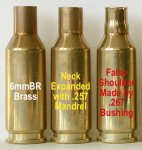Long story short, I've been getting case head separation after 3 firings with my custom 300wm. After a bit of research, I purchased a Hornady headspace gauge and I have been FL sizing and bumping the shoulder way too much. I'm not new to reloading however this is my first experience with a belted magnum. I'm using Hornady dies and by looking on this page, it seems most use Forster or Redding. My temporary solution was to readjust the die for a .002 bump. Will this effectively eliminate my issue or should I consider altering my process altogether and going with a different die set?
What does your process for belted magnums look like?
What does your process for belted magnums look like?


